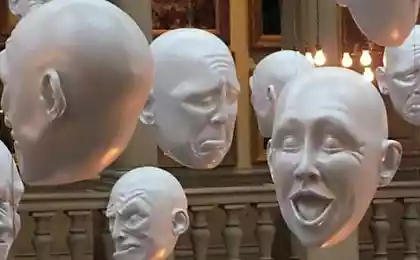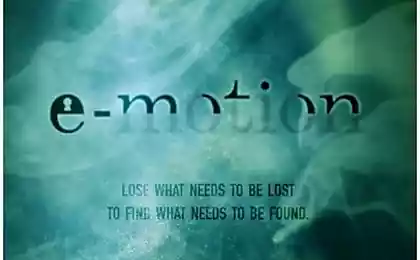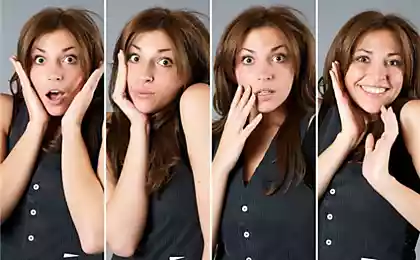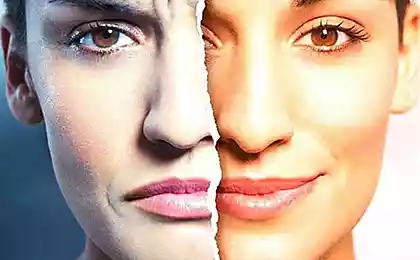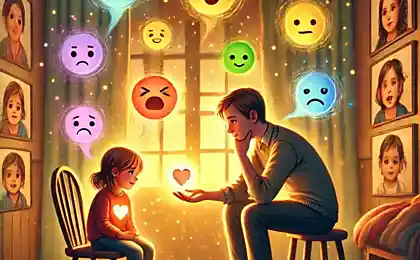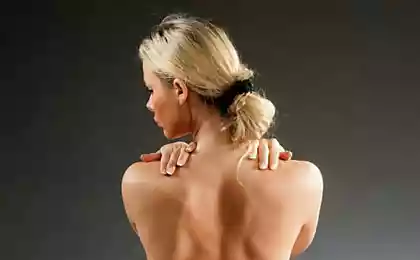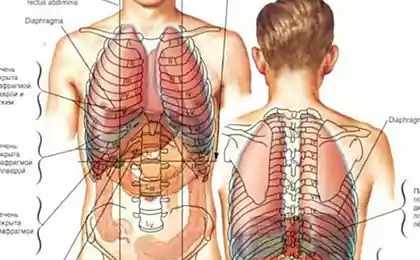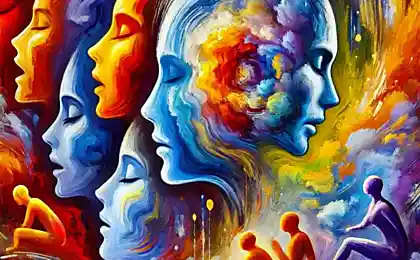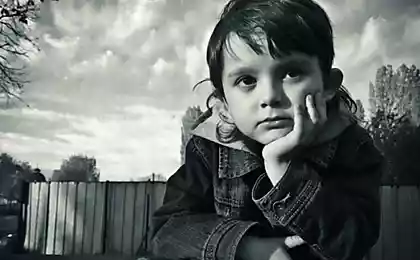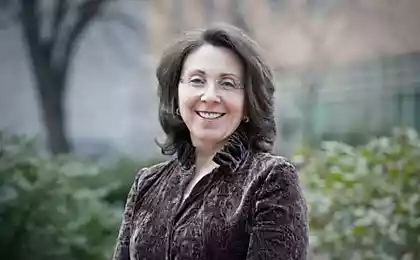605
Where are our emotions?
Modern culture tends to hide and suppress their emotions, not to Express their true feelings. Instead, you're supposed to wear a mask, and best of all keep smiling (keep smiling). A child is brought to the prohibitions on the expression of emotions: "don't cry", "don't go", "slow down", "be quiet", "sit quietly", "not gramatnica"; forbidden to "Express" anger, rage, and aggression in General.
Any emotion is energy, and, according to the law of conservation of energy, it does not disappear. It is therefore possible to suppress the expression of the emotions, but not to destroy it. She continues to live deep in man being undeveloped, and does not disappear until then, until it is expressed outward.
Seventy one million thirty three thousand four hundred seventy nine
EMOTIONS.
What is "emotion"? The word emotio implies the action of (preposition e–, "out, outside", motio – "movement"), and in this sense, emotion ("move outwards") is a universal manifestation of all life forms. Back in 1872. Charles Darwin in his book "the Expression of the emotions in man and animals" wrote: "the Expressive movements of the face and body is extremely important for our wellbeing." Later, Sigmund Freud found that the therapeutic effect is achieved only when you experience emotions.
Every emotion, in its own way, experienced our body. Joy — "bursting Breasts", from the insult — "in my chest ached," from disgust — "the stomach turns" shame – like "burn" (burning sensation in the diaphragm), and the fear — "goose bumps". Emotion always requires expression facial expressions (facial muscles), gestures (mainly the muscles of the arms and shoulder girdle), movements of the body (muscles).
But for the expression of emotions required and the energy provided by a deep breath. Therefore, for the normal expression of emotions necessary free, plastic condition of the muscles of the face and body, free, easy and deep breathing.
CONTAINMENT OF EMOTIONS.
If we restrain the outward expression of our emotions, to hide them from people, then that is accomplished by just inhibiting their expression of their muscles. Interfering with the normal operation of the body's own inhibiting muscle movement. If some sense is very strong, and we long and long to restrain him – they form muscle blocks which, in turn, violate in General, the work of the relevant body segment, not only the expression of the feelings.
Suppressed expression of emotions by the tension of the muscles and locking of the segments of the body corresponding to this emotion. In many instances, not only the expression of specific emotions, but emotions in General, by reducing the energy requirements of the body, weakening the depth of breathing. It is often accompanied by a predisposition to colds. Based on the blocking of breathing is the unconscious fear of getting a stream of energy that strikes all the muscle blocks, and emotions will come out.
CONSEQUENCES of deterrence emotions.
What happens to us while keeping yourself, the limitation in the expression of feelings and emotions?
Unbeknownst to us, this leads to the fact that:
• neuroses are formed,
• there is a painful feeling that do not live their lives,
• does not do what you want,
• suffering, justifying the fact that, supposedly, "all that live", "nothing to do", etc.
• our close loses that we love and tenderness, that we are not able to Express,
• "swallow insults" instead of fight back, etc.
Blocked energy "circulates" inside our bodies to find the exit.
Man continues to be pulses of unexpressed emotions but is struggling with them. As a result, the body, instead of bringing joy, brings pain and suffering, "earns" disease (psychosomatics). The man turns away from his own body betrays him (one of the books known psychotherapist Alexander Lowen is called "Betrayal of the body – the Betrayal of the body" ). What but harm can bring a person ignoring his mind his own body?
Our bodies reflect our experiences.
Example. Resentment "squeezes" the breast regardless of whether the person shows his resentment to the people or no-shows. After some time, if, being unexpressed, resentment does not pass, you may experience pain in the back between the shoulder blades. You can go to the masseur, but the treatments will only bring temporary relief. He can even put an incorrect diagnosis of "osteochondrosis of the thoracic". But while he will not remove the breast unit and will not give his offense back will not work…
Example. An increased control of reason over emotions leads to the formation of the neck block. "Sandwiched" neck, in turn, leads to a stooped posture, neck pain, respiratory diseases, chronic colds. (That happens with the voice, we'll explain later). Can help the massage therapist? Again will be mistaken diagnosis of "osteochondrosis", but now "cervical". But this man can learn to Express their emotions, and stop trying to hold my screaming, crying ("lump in my throat" )...
WHERE YOU LIVE EMOTIONS.
So where do emotions live? Lowen highlights 9 "basic" emotions:
-Basic emotion — Where there lives the Feeling caused in this area
-Joy — chest expanding, lifting, opening
-Sadness — chest compression, reduction
-Hurt — breast reduction, compression
-Tenderness in the breast a pleasant warmth, expansion, the "expansion»
-Anger in the chest, goes out of the pelvis, passes up through the body "bursting", the expansion
-Shame — the area of the diaphragm (between the chest and the abdomen) burning
-Disgust — the top abdominal compression, turning, turning
-Fear — abdomen compression, compression, reduction
-Sexual arousal — pelvic nice extension, "the spill".
Perhaps this list looks too lightweight. There are not many well-known emotions and feelings: anger, sadness, guilt, etc. Because it is about basic emotions. Other emotions are "surface", ie the "tops" of base. Under the "surface" emotion always has a base. The base is always more authentic and has much more energy than any surface. So with all the possible diversity of feelings and emotions, Lowen recommends for therapeutic purposes is always to identify the underlying emotion.
That offers to do body-oriented psychotherapy?
Understanding the unity of mind and body allows in body-oriented psychotherapy is not only to diagnose the psychological causes of bodily diseases, but also eliminate them. Because the muscular unit can be removed, and you can teach people to be held to his own feelings and emotions.
It is impossible to make the movements graceful, just lying on the couch or sitting in a chair and talking about their experiences. Such a conversation is necessary and useful, but with chronic muscle tension, which is accompanied by the loss of grace, need to struggle in traffic.
"All the emotions belong to the body, the mind only recognizes."D. Lawrence.
Scary to show people your true emotions, right? And even myself to admit it is scary. If you answer "Yes", then view the table where fear lives? And start working!
Exercise.
Study his face.
Come to the mirror. Carefully look at the long-established features. What emotion do they represent? Raised eyebrows? In surprise or fright? Or maybe shifted? With rage? The corners of the mouth down? In sorrow? Or years smile froze on his lips? And smile then eyes? Or just lips? Or maybe eyes wide open? In fright? Lip turned outwards? In disgust? Or the stress involved, becoming a thin line? With anger? The cheeks are inflated? Like a child who's about to cry? Or face looking drawn and muscles tensed? From pain and suffering? Take a look...This look of a man who wants to grin like a Cheshire cat? And maybe to cry? Will attention to yourself…
"Every person, in order to maintain mental health, should make faces at her reflection in the mirror is not less than 3 minutes daily. published
P. S. And remember, only by changing their consumption — together we change the world! ©
Join us in Facebook , Vkontakte, Odnoklassniki
Source: vk.com/studiya_zen?w=wall-28623892_3146
Any emotion is energy, and, according to the law of conservation of energy, it does not disappear. It is therefore possible to suppress the expression of the emotions, but not to destroy it. She continues to live deep in man being undeveloped, and does not disappear until then, until it is expressed outward.
Seventy one million thirty three thousand four hundred seventy nine
EMOTIONS.
What is "emotion"? The word emotio implies the action of (preposition e–, "out, outside", motio – "movement"), and in this sense, emotion ("move outwards") is a universal manifestation of all life forms. Back in 1872. Charles Darwin in his book "the Expression of the emotions in man and animals" wrote: "the Expressive movements of the face and body is extremely important for our wellbeing." Later, Sigmund Freud found that the therapeutic effect is achieved only when you experience emotions.
Every emotion, in its own way, experienced our body. Joy — "bursting Breasts", from the insult — "in my chest ached," from disgust — "the stomach turns" shame – like "burn" (burning sensation in the diaphragm), and the fear — "goose bumps". Emotion always requires expression facial expressions (facial muscles), gestures (mainly the muscles of the arms and shoulder girdle), movements of the body (muscles).
But for the expression of emotions required and the energy provided by a deep breath. Therefore, for the normal expression of emotions necessary free, plastic condition of the muscles of the face and body, free, easy and deep breathing.
CONTAINMENT OF EMOTIONS.
If we restrain the outward expression of our emotions, to hide them from people, then that is accomplished by just inhibiting their expression of their muscles. Interfering with the normal operation of the body's own inhibiting muscle movement. If some sense is very strong, and we long and long to restrain him – they form muscle blocks which, in turn, violate in General, the work of the relevant body segment, not only the expression of the feelings.
Suppressed expression of emotions by the tension of the muscles and locking of the segments of the body corresponding to this emotion. In many instances, not only the expression of specific emotions, but emotions in General, by reducing the energy requirements of the body, weakening the depth of breathing. It is often accompanied by a predisposition to colds. Based on the blocking of breathing is the unconscious fear of getting a stream of energy that strikes all the muscle blocks, and emotions will come out.
CONSEQUENCES of deterrence emotions.
What happens to us while keeping yourself, the limitation in the expression of feelings and emotions?
Unbeknownst to us, this leads to the fact that:
• neuroses are formed,
• there is a painful feeling that do not live their lives,
• does not do what you want,
• suffering, justifying the fact that, supposedly, "all that live", "nothing to do", etc.
• our close loses that we love and tenderness, that we are not able to Express,
• "swallow insults" instead of fight back, etc.
Blocked energy "circulates" inside our bodies to find the exit.
Man continues to be pulses of unexpressed emotions but is struggling with them. As a result, the body, instead of bringing joy, brings pain and suffering, "earns" disease (psychosomatics). The man turns away from his own body betrays him (one of the books known psychotherapist Alexander Lowen is called "Betrayal of the body – the Betrayal of the body" ). What but harm can bring a person ignoring his mind his own body?
Our bodies reflect our experiences.
Example. Resentment "squeezes" the breast regardless of whether the person shows his resentment to the people or no-shows. After some time, if, being unexpressed, resentment does not pass, you may experience pain in the back between the shoulder blades. You can go to the masseur, but the treatments will only bring temporary relief. He can even put an incorrect diagnosis of "osteochondrosis of the thoracic". But while he will not remove the breast unit and will not give his offense back will not work…
Example. An increased control of reason over emotions leads to the formation of the neck block. "Sandwiched" neck, in turn, leads to a stooped posture, neck pain, respiratory diseases, chronic colds. (That happens with the voice, we'll explain later). Can help the massage therapist? Again will be mistaken diagnosis of "osteochondrosis", but now "cervical". But this man can learn to Express their emotions, and stop trying to hold my screaming, crying ("lump in my throat" )...
WHERE YOU LIVE EMOTIONS.
So where do emotions live? Lowen highlights 9 "basic" emotions:
-Basic emotion — Where there lives the Feeling caused in this area
-Joy — chest expanding, lifting, opening
-Sadness — chest compression, reduction
-Hurt — breast reduction, compression
-Tenderness in the breast a pleasant warmth, expansion, the "expansion»
-Anger in the chest, goes out of the pelvis, passes up through the body "bursting", the expansion
-Shame — the area of the diaphragm (between the chest and the abdomen) burning
-Disgust — the top abdominal compression, turning, turning
-Fear — abdomen compression, compression, reduction
-Sexual arousal — pelvic nice extension, "the spill".
Perhaps this list looks too lightweight. There are not many well-known emotions and feelings: anger, sadness, guilt, etc. Because it is about basic emotions. Other emotions are "surface", ie the "tops" of base. Under the "surface" emotion always has a base. The base is always more authentic and has much more energy than any surface. So with all the possible diversity of feelings and emotions, Lowen recommends for therapeutic purposes is always to identify the underlying emotion.
That offers to do body-oriented psychotherapy?
Understanding the unity of mind and body allows in body-oriented psychotherapy is not only to diagnose the psychological causes of bodily diseases, but also eliminate them. Because the muscular unit can be removed, and you can teach people to be held to his own feelings and emotions.
It is impossible to make the movements graceful, just lying on the couch or sitting in a chair and talking about their experiences. Such a conversation is necessary and useful, but with chronic muscle tension, which is accompanied by the loss of grace, need to struggle in traffic.
"All the emotions belong to the body, the mind only recognizes."D. Lawrence.
Scary to show people your true emotions, right? And even myself to admit it is scary. If you answer "Yes", then view the table where fear lives? And start working!
Exercise.
Study his face.
Come to the mirror. Carefully look at the long-established features. What emotion do they represent? Raised eyebrows? In surprise or fright? Or maybe shifted? With rage? The corners of the mouth down? In sorrow? Or years smile froze on his lips? And smile then eyes? Or just lips? Or maybe eyes wide open? In fright? Lip turned outwards? In disgust? Or the stress involved, becoming a thin line? With anger? The cheeks are inflated? Like a child who's about to cry? Or face looking drawn and muscles tensed? From pain and suffering? Take a look...This look of a man who wants to grin like a Cheshire cat? And maybe to cry? Will attention to yourself…
"Every person, in order to maintain mental health, should make faces at her reflection in the mirror is not less than 3 minutes daily. published
P. S. And remember, only by changing their consumption — together we change the world! ©
Join us in Facebook , Vkontakte, Odnoklassniki
Source: vk.com/studiya_zen?w=wall-28623892_3146




